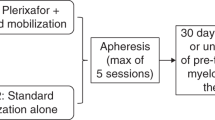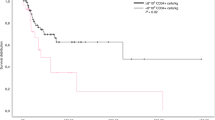Abstract
We assessed the mobilization capacity of taxol with rhG-CSF, both as a single chemotherapeutic agent and in the presence of cyclophosphamide (CY), and compared the effect with yields achieved when mobilization was performed solely with rhG-CSF. Fifteen patients with breast cancer received taxol 170 mg/m2 (continuous infusion, day 1) and rhG-CSF (8 μg/kg/day, from day 2 until the end of apheresis) (T-G group), while seven breast cancer patients were additionally treated with CY (4 g/m2) on day 2, followed by rhG-CSF starting at similar doses on day 3 (T-CY-G group). The PBSC collections after taxol with/without CY were compared with those of 30 breast cancer patients who had received rhG-CSF (8 μg/kg/day) for mobilization. No differences were found in the characteristics of patients included in any of the three mobilization groups. The median yield of CD34+ cells from all patients included in taxol containing schedules was 9 × 106/kg (range 2–26) collected with a median of one apheresis procedure (range 1–4). Leukaphereses began earlier in the T-G group (median day 8, range 7–10) than in the T-CY-G group (median day 13, range 11–17). In most patients (20 out of 22) who received taxol containing regimens, more than 2.5 × 106 CD34+ cells/kg, a threshold considered to be sufficient for hematopoietic reconstitution, were collected with a single apheresis. Those patients in the T-G group experienced less neutropenic and thrombocytopenic days, with all neutropenic fever episodes developing in patients treated with the T-CY-G schedule (43%). When considering priming with rhG-CSF alone in our historical cohort of 30 breast cancer patients, a significant detrimental effect was observed in comparison with taxol mobilizing schedules, in the number of aphereses performed, in the total yield CD34+cells and in the number of patients who achieved the target dose of 2.5 × 106/kg CD34+ cells within the first collection procedure. We conclude that taxol containing schedules are effective in mobilizing PBSC and facilitate the collection of high yields of CD34+ cells (usually more than 5 × 106/kg recipient body weight) with a reduced number of apheresis procedures. Taxol, as a single agent with rhG-CSF, exhibits less hematological toxicity than the combination chemotherapy mobilization regimen including CY. Bone Marrow Transplantation (2000) 25, 231–235.
This is a preview of subscription content, access via your institution
Access options
Subscribe to this journal
Receive 12 print issues and online access
$259.00 per year
only $21.58 per issue
Buy this article
- Purchase on Springer Link
- Instant access to full article PDF
Prices may be subject to local taxes which are calculated during checkout
Similar content being viewed by others
References
Bensinger W, Appelbaum F, Rowley S et al. Factors that influence collection and engraftment of autologous peripheral blood stem cells J Clin Oncol 1995 13: 2547–2555
Eisenhauer EA, Vermorken JB . The taxoids. Comparative clinical pharmacology and therapeutic potential Drugs 1998 55: 5–30
Demirer T, Rowley S, Buckner D et al. Peripheral blood stem cell collection after paclitaxel, cyclophosphamide, and recombinant human granulocyte colony-stimulating factor in patients with breast and ovarian cancer J Clin Oncol 1995 13: 1714–1719
Shea TC . Mobilization of peripheral blood progenitor cells with paclitaxel-based chemotherapy Semin Oncol 1997 24: (Suppl.2) 105–107
Weaver CH, Schwartzberg LS, Birch R et al. Collection of peripheral blood stem cells following administration of paclitaxel, cyclophosphamide, and filgrastim in patients with breast and ovarian cancer Biol Blood Marrow Transplant 1997 3: 83–90
Pedrazzoli P, Perotti C, Da Prada GA et al. Collection of circulating progenitor cells after epirubicin, paclitaxel and filgrastim in patients with metastatic breast cancer Br J Cancer 1997 75: 1368–1372
Bengala C, Pazzagli Y, Tibaldi C et al. Mobilization, collection, and characterisation of peripheral blood hematopoietic progenitors after chemotherapy with epirubicin, paclitaxel and granulocyte-colony stimulating factor administered to patients with metastatic breast carcinoma Cancer 1998 85: 867–873
Demirer T, Buckner CD, Storer B et al. Effect of different chemotherapy regimens on peripheral-blood stem cell collection in patients with breast cancer receiving granulocyte colony stimulating factor J Clin Oncol 1997 15: 684–690
De Arriba F, Lozano ML, Ortuño F et al. Prospective randomised study comparing the efficacy of bioequivalent doses of glycosylated and nonglycosylated rhG-CSF for mobilizing peripheral blood progenitor cells Br J Haematol 1997 96: 418–420
Sutherland DR, Anania S, Nayar R et al. Accurate enumeration of CD34+ cells in bone marrow and peripheral blood of patients after chemotherapy and GM-CSF Exp Haematol 1993 21: 1163–1166
Burtness BA, Psyrri A, Rose M et al. A phase I study of paclitaxel for mobilization of peripheral blood progenitor cells Bone Marrow Transplant 1999 23: 311–315
Burtness B, Henderson-Bakas M, Di Andrea E . Single agent paclitaxel mobilized CD34+ cells effectively Proc Am Soc Clin Oncol 1995 14: 108 (Abstr.)
Rajagopal C, Areman E, Verman U et al. Paclitaxel as a single agent is superior to cyclophosphamide for mobilizing CD34+ cell transplantation Blood 1995 86: (Suppl.1) 405a
Ketterer N, Salles G, Raba M et al. High CD34+ counts decrease hematologic toxicity of autologous peripheral blood progenitor cell transplantation Blood 1998 9: 3148–3155
Olivieri A, Offidani M, Montarani M et al. Factors affecting hematopietic recovery after high dose therapy and autologous peripheral blood progenitor cell transplantation: a single center experience Haematologica 1998 83: 329–337
Weaver CH, Potz J, Redmond J et al. Engraftment and outcomes of patients receiving myeloablative therapy followed by autologous peripheral blood stem cells with a low CD34+ cell content Bone Marrow Transplant 1997 19: 1103–1110
Schwella N, Beyer I, Schwaner I et al. Impact of preleukapheresis cell counts on collection results and correlation of progenitor-cell dose with engraftment after high-dose chemotherapy in patients with germ cell cancer J Clin Oncol 1996 14: 1114–1121
Acknowledgements
This work was supported by a grant from ‘Fundacion Hefame’.
Author information
Authors and Affiliations
Rights and permissions
About this article
Cite this article
Gómez-Espuch, J., Moraleda, J., Ortuño, F. et al. Mobilization of hematopoietic progenitor cells with paclitaxel (taxol) as a single chemotheraupetic agent, associated with rhG-CSF. Bone Marrow Transplant 25, 231–235 (2000). https://doi.org/10.1038/sj.bmt.1702130
Received:
Accepted:
Published:
Issue Date:
DOI: https://doi.org/10.1038/sj.bmt.1702130
Keywords
This article is cited by
-
Mobilization of peripheral blood stem cells using regimen combining docetaxel with granulocyte colony-stimulating factor in breast cancer patients
Chinese Journal of Cancer Research (2011)
-
High-dose epirubicin, preceded by dexrazoxane, given in combination with paclitaxel plus filgrastim provides an effective mobilizing regimen to support three courses of high-dose dense chemotherapy in patients with high-risk stage II–IIIA breast cancer
Bone Marrow Transplantation (2003)
-
A phase II trial of docetaxel for peripheral blood stem cell mobilization for patients with breast cancer and ovarian cancer
Bone Marrow Transplantation (2001)



